Captain Robert Riddell (1755–1794), Laird of Friar's Carse, near Dumfries.

Poems, Chiefly in the Scottish Dialect, commonly known as the Kilmarnock Edition, is a collection of poetry by the Scottish poet Robert Burns, first printed and issued by John Wilson of Kilmarnock on 31 July 1786. It was the first published edition of Burns' work. In mid-April 1786, Burns sent out printed Proposals for what was then titled Scotch Poems asking for people to sign up as subscribers, printing began on June 13, and the first copies were ready for distribution by July 31. 612 copies were printed. The book cost three shillings, in a temporary paper binding that most purchasers soon had replaced. There is no formal dedication at the start of the book, but Burns includes a dedication poem to Gavin Hamilton at pp. 185-191, and "The Cotter's Saturday Night" is "inscribed to R.A. Esq.," i.e. Robert Aitken.

Jean Armour, also known as the "Belle of Mauchline", was the wife of the poet Robert Burns. She inspired many of his poems and bore him nine children, three of whom survived into adulthood.

Friars' Carse is a mansion house and estate situated 2 kilometres (1.2 mi) southeast of Auldgirth on the main road (A76) to Dumfries, Parish of Dunscore, Scotland. The property is located on the west bank of the River Nith and is known for its strong associations with Robert Burns who lived for a while at the nearby Ellisland farm. The mansion house is unlisted, however the stables and hermitage are Category B listed buildings.
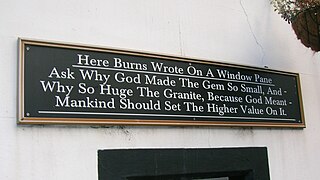
Robert Burns came to know James Cunninghamme, Earl of Glencairn in Edinburgh in 1786 through a 'Letter of Introduction' provided by Dalrymple of Orangefield who was married to Lady Glencairn's sister. The Earl received the poet warmly in his house and introduced him to his friends. One of several gifts from the earl to the poet was a diamond point pen, stylus, or cutter which he used to write upon many windowpanes and glasses, scribing verse, his signature, epigrams, or other writings for posterity. Many of these diamond-point engravings survive, some however are contentious as regards either their authenticity, meaning, or both.
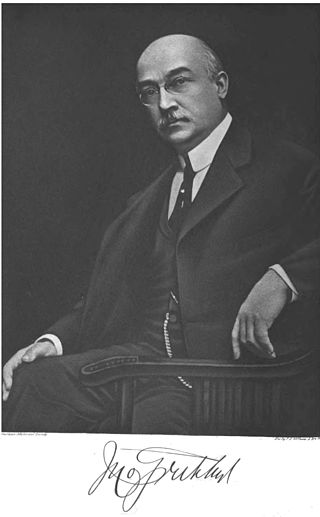
John Gribbel was an American businessman, industrialist and philanthropist. He is best remembered for his donation of the Glenriddell Manuscripts to the National Library of Scotland.

The Hermitage was a folly first built by Captain Robert Riddell of Friars Carse as part of his enthusiasm for antiquities. It is famous for its connection with the bard Robert Burns who through his friendship with Riddell was permitted to use it to compose poetry in this secluded and tranquil sylvan spot. Burns also used his diamond point pen to engrave lines on the window pane at the Hermitage following the premature death of Riddell. The original Hermitage fell into disrepair and was rebuilt in 1874. It was further restored to its former glory more recently (2009).

Poems, Chiefly in the Scottish Dialect is commonly known as the first Edinburgh Edition and the partial second setting has become known as the Stinking Edition. It is a collection of poetry and songs by Robert Burns, first "Printed for the Author" by William Smellie in Edinburgh and published or "Sold by William Creech" of Edinburgh on the 17 April, an announcement being made in the Edinburgh Advertiser on that date, although the date 21 April 1786 is given by a few authors. The Kilmarnock Edition made Robert Burns Caledonia's Bard whilst the 'Edinburgh Edition' elevated him into a position amongst the world's greatest poets.

Poems is a collection of poetry and songs by David Sillar, a close friend of the poet Robert Burns who had been encouraged to go into print by the success of Poems, Chiefly in the Scottish Dialect. Poems was printed by John Wilson of Kilmarnock in 1789. Sillar's interest in poetry predated his friendship with Burns, but was one of several reasons for it.
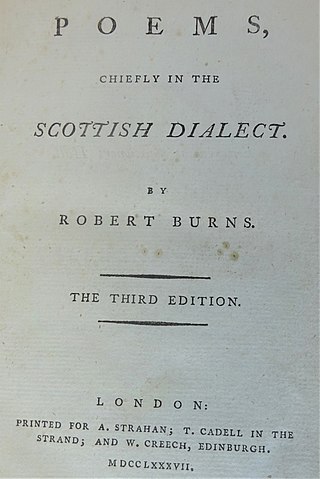
Poems, Chiefly in the Scottish Dialect is commonly known as the Third or London Edition and sometimes the Stinking Edition. It is a collection of poetry and songs by Robert Burns, printed for A. Strahan; T. Cadell in the Strand; and W. Creech, Edinburgh. MDCCLXXXVII The date of publication for the London Edition was in November 1787, however Strahan and Cadell had previously advertised for sale the 'Second' or 'Edinburgh Edition' using the 500 or so copies that William Creech still had that were unsold. The successful selling of these made a truly new 'London Edition' a commercially viable enterprise.

Duncan McNaught LL.D., J.P., was born in Alexandria, Dunbartonshire in 1845. He was the parochial school teacher at Kilmaurs in East Ayrshire from 1867 and served at the school for over fifty years, having served as assistant from 1865. He founded the Kilmarnock Conservative Association, jointly founded the Robert Burns World Federation, acted as the editor of the "Burns Chronicle" and was the president of what became the Robert Burns World Federation.

Poems, Chiefly in the Scottish Dialect was issued during the poet's lifetime In Two Volumes. The Second Edition Considerably Enlarged. It is a collection of poetry and songs by the poet Robert Burns, printed for T. Cadell, London, and W. Creech, Edinburgh. M,DCC,XCIII The date of publication for this edition was 16 February 1793 as advertised in the Edinburgh Courant. The successful demand for the 1787 Edinburgh Edition seems to have encouraged Creech to publish this new edition as the 1787 volume had been sold out since around 1791.

Robert Burns's Commonplace Book 1783–1785 is the first of three commonplace books that were produced by the poet. The contents cover drafts of songs and poems, observations, ideas, epitaphs, etc.

'Robert Burns's Interleaved Scots Musical Museum' or the 'Interleaved Glenriddell Manuscript' is a set of four octavo volumes of James Johnson's The Scots Musical Museum in which Robert Burns provided additional material to the original publication on interleaved sheets and which he eventually gifted to Captain Robert Riddell (1755–94) of Friars Carse, Dumfries and Galloway, Scotland.
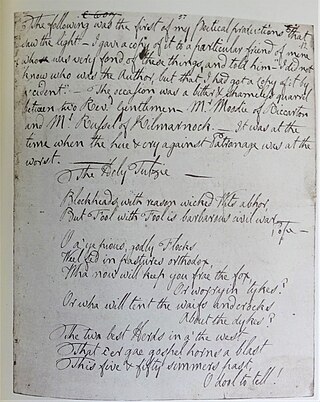
'The Holy Tulzie', 'The Twa Herds' or 'An Unco Mournfu' Tale was a poem written in 1784 by Robert Burns whilst living at Mossgiel, Mauchline, about a strong disagreement, not on doctrine, but on the parish boundaries, between two 'Auld Licht' ministers, John Russel and Alexander Moodie It was followed by "The Holy Fair", "The Ordination", "The Kirk's Alarm", "Holy Willie's Prayer", etc.

The surviving manuscript of the instructional work A Manual of Religious Belief is written in the form of a theological dialogue between father and child written out in holograph by John Murdoch for William Burnes, Robert Burns's father. William had started to compose and compile the work before Robert Burns's birth and wrote the first rough draft that has not survived. This work was originally composed with a stronger Scots language content that Murdoch modified, as well as making grammatical corrections.
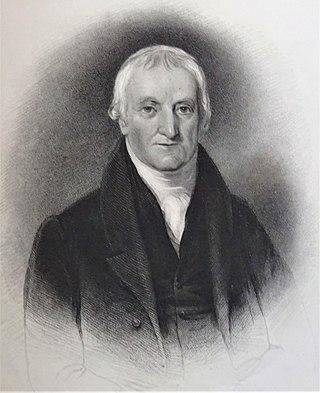
John Syme was a Scottish lawyer and one of the poet Robert Burns's closest friends during his time in Dumfries. In the summers of 1793 and 1794 he joined Burns on his two short tours of Galloway. Syme and Alexander Cunningham were amongst the most active of the friends and admirers of Burns's works who raised funds for the poet's family and for his mausoleum with the assistance of others such as James Currie. Together with Dr Willam Maxwell he arranged Burns's funeral.

The Geddes Burns is a copy of Robert Burns's 1787 Poems, Chiefly in the Scottish Dialect with twenty-seven extra pages with twelve poems and songs in Burns's handwriting bound in, and a letter to Catholic Bishop John Geddes from the poet, written at Ellisland Farm.

James Glencairn Burns (1794–1865) was the fourth son and eighth child born to the poet Robert Burns and his wife Jean Armour. James was born at their home in Mill Brae Street, now Burns Street in Dumfries on 12 August 1794. His first and middle name was added in honour of James Cunningham, 14th Earl of Glencairn, Robert's friend, patron and mentor.

Poems, Chiefly in the Scottish Dialect was a 'pirated' edition of Robert Burns's work, being published in Ireland without permission from or payment to the author or publisher. It is a so-called 'Stinking Edition', carrying the error 'Stinking' for the Scots word 'Skinking' (watery) in the poem "To a Haggis" because the type setters copied from a 1787 'Stinking Edition' of Poems, Chiefly in the Scottish Dialect .























